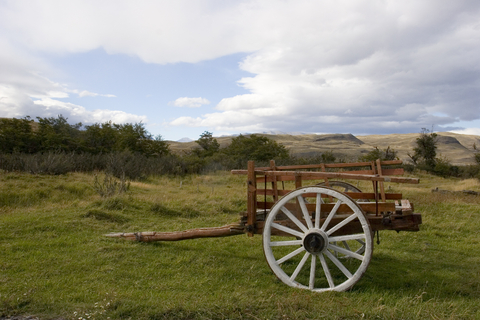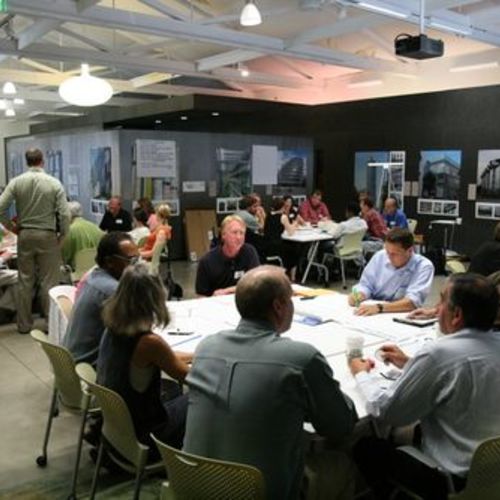
Okay, so you’ve put your stellar team together, and everyone’s agreed about how the integrated design process is going to unfold. It may be new to them, but they’re game. Now you’re going to hold a charrette to kick off the process. What happens there?
First of all, what’s a “charrette” anyway?
It’s a French word meaning “cart” and alludes to the earliest days of architecture as a formal discipline taught at the Ecôle des Beaux Arts in Paris. Architecture students, at deadline time, had to deposit their finished projects onto a cart that made the rounds of the studios at a designated hour.
The term is now used to mean something quite different, namely, a workshop, or collaborative design or brainstorming session. (Maybe it’s a reference to the solidarity in that moment of panic when the cart came rumbling past. . . .)
Annette Stelmack gave a terrific description of the charrette experience in her March 17 blog. It’s a great forum for gathering all the collective wisdom, experience, and insight of the project’s team members. The central feature of a charrette, from my perspective, is that it’s all about learning.
There are a few critical agenda items for the kick-off charrette:
- Identify the major factors that will influence the design (“form shapers”).
- Set performance goals.
- Outline the steps in the integrated design process.
Form shapers
These may be numerous and varied, and include climate, topography, vegetation and other aspects of the site or habitat in which the project will be placed. They also include political realities, typically manifested in zoning regulations and/or local building codes. And of course the owner’s or developer’s programmatic needs — functional, aesthetic, budgetary, etc. — are always significant form shapers.
Performance goals
For green (or “sustainable” or “environmentally sensitive” or “regenerative”) projects, establishing environmental performance goals is a crucial step, and it’s important to do so as early as possible. The risk in waiting is that these goals may then become viewed as “extras” — add-ons to the project — rather than as integral to the project and on equal footing with other aspects of performance.
Most design professionals assume that their charge encompasses delivering a project that responds to functional needs, aesthetic preferences, and cost constraints — whether they are explicitly told this is so or not. I advocate adding to this list three more fundamental goals: durability, occupant well-being, and resource efficiency. These, in my humble opinion, are the “trinity” of green design. And furthermore, I challenge any designer to articulate the complete list of six deliverables to a client and have them say, “No, actually, those last three don’t interest me!” It hasn’t happened yet (not to me, anyway).
Once those are on the table, the next step is to prioritize them. Design is inevitably a process of trade-offs, and it’s hard to make trade-offs when you haven’t set priorities. So hard as it may be, get your client to tell you which of these values he/she holds most dear.
And then, talk about specific performance goals. How energy efficient? Compared to what? Each parameter of environmental performance should be evaluated and a performance target set. This can be a rigorous quantitative exercise or a somewhat more perfunctory one, but the more specific you are, the easier it will be to flesh out the design. You may find it helpful to use a green rating system, e.g., LEED for Homes, the National Association of Home Builder’s National Green Building Standard, or a local program, as a framework for setting your performance targets.
One of the values of having your full team present starts to be obvious at this point, because each participant will have something to offer about the types of performance goals that are attainable, at what effort or cost, and what the trade-offs may be. Right away you’ll begin to see that the variety of input from team members starts shaping the design process. Decisions don’t need to be made yet, necessarily, but you’ll begin gathering information that will be very useful as the design progresses. And you might actually make some decisions, right there and then.
Outline the process
Before you wrap up the first charrette, talk about how the rest of the process should unfold. Identify, as best you can, the major decisions that will need to be made and how team members will collaborate to make those decisions. Establish follow-up responsibility for things that need further research, and create a time line for subsequent steps in the collaborative process. Be sure to designate someone to be the keeper of the process and time line. If there’s one thing I’ve learned from 30 years in the business, it’s that we can all use a little adult supervision (and I’m no exception!).
Weekly Newsletter
Get building science and energy efficiency advice, plus special offers, in your inbox.














0 Comments
Log in or create an account to post a comment.
Sign up Log in